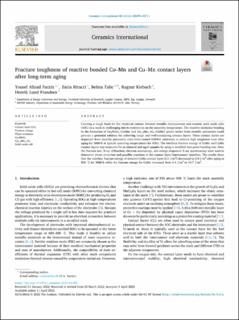| dc.contributor.author | Farzin, Yousef Alizad | |
| dc.contributor.author | Ritucci, Ilaria | |
| dc.contributor.author | Talic, Belma | |
| dc.contributor.author | Kiebach, Ragnar | |
| dc.contributor.author | Frandsen, Henrik Lund | |
| dc.date.accessioned | 2022-08-05T12:23:10Z | |
| dc.date.available | 2022-08-05T12:23:10Z | |
| dc.date.created | 2022-04-29T13:38:04Z | |
| dc.date.issued | 2022 | |
| dc.identifier.citation | Ceramics International. 2022, 48 (14), 20699-20711. | en_US |
| dc.identifier.issn | 0272-8842 | |
| dc.identifier.uri | https://hdl.handle.net/11250/3010371 | |
| dc.description.abstract | Creating a tough bond for the electrical contact between metallic interconnects and ceramic solid oxide cells (SOC) in a stack is challenging due to restrictions on the assembly temperature. The reactive oxidation bonding in the formation of Co2MnO4 (CoMn) and Cu1.3Mn1.7O4 (CuMn) spinel oxides from metallic precursors could provide a potential solution for achieving tough and well-conducting contact layers. These contact layers are deposited from metallic precursors onto CoCe-coated AISI441 substrates to achieve high toughness even after aging for 3000 h at typical operating temperatures for SOCs. The interface fracture energy of CoMn and CuMn contact layers was measured for as-sintered and aged samples by using a modified four-point bending test. After the fracture test, X-ray diffraction, electron microscopy, and energy-dispersive X-ray spectroscopy were used to determine phase evolution and possible reactions at the contact layer/interconnect interface. The results show that the interface fracture energy of sintered CoMn contact layer (6.1 J/m2) decreased to 2.9 J/m2 after aging at 850 ○C for 3000 h while the fracture energy for CuMn increased from 6.4 J/m2 to 19.7 J/m2. | en_US |
| dc.language.iso | eng | en_US |
| dc.publisher | Elsevier | en_US |
| dc.rights | Navngivelse 4.0 Internasjonal | * |
| dc.rights.uri | http://creativecommons.org/licenses/by/4.0/deed.no | * |
| dc.subject | Solid oxide cell | en_US |
| dc.subject | Cu1.3Mn1.7O4 | en_US |
| dc.subject | Co2MnO4 | en_US |
| dc.subject | Phase evolution | en_US |
| dc.subject | Fracture energy | en_US |
| dc.subject | Contact layer (CL) | en_US |
| dc.title | Fracture toughness of reactive bonded Co–Mn and Cu–Mn contact layers after long-term aging | en_US |
| dc.title.alternative | Fracture toughness of reactive bonded Co–Mn and Cu–Mn contact layers after long-term aging | en_US |
| dc.type | Peer reviewed | en_US |
| dc.type | Journal article | en_US |
| dc.description.version | publishedVersion | en_US |
| dc.rights.holder | © 2022 The Authors. Published by Elsevier Ltd. | en_US |
| dc.source.pagenumber | 20699-20711 | en_US |
| dc.source.volume | 48 | en_US |
| dc.source.journal | Ceramics International | en_US |
| dc.source.issue | 14 | en_US |
| dc.identifier.doi | 10.1016/j.ceramint.2022.04.050 | |
| dc.identifier.cristin | 2020157 | |
| dc.relation.project | EC/H2020/826323 | en_US |
| cristin.ispublished | true | |
| cristin.fulltext | original | |
| cristin.qualitycode | 1 | |

